|
|
|
Mar 24, 2020 17:04:16 GMT
|
Is your 200 still running at 80 degrees? Have you managed to fix it (does it need fixing?)? How is your (manual) idling? How smooth is it? When driven slowly around town, engine temperature goes up to high 80s deg C, then the electric fan kicks in and keeps the temperature at around 80-85 deg C. However, when driven on the motorway or on clear roads on a cold day, the temperature drops down by approx 20 deg C. I have removed the original fan assembly and fitted the electric fan that does not kick in until the engine reaches high 80s deg C, I have replaced the thermostat with a new correct part from Mercedes, I have replaced the thermostat housing with a metal one (the plastic ones have been known to crack) and I have replaced the coolant with correct grade anti-freeze. I don't know what else I can do to get the engine to the right temperature and make it stay there. In comparison, my 230E will quickly reach 87 deg C and the temperature will stay at that level regardless of weather conditions or driving style. |
| |
|
|
|
|
|
|
|
Mar 24, 2020 17:05:37 GMT
|
|
PS - the 200E idles just fine, once warmed up, within 60 seconds of start up, the engine ticks over at approx 700 rev/min. During the MoT last week, the CO reading was 0.7% and the tester commented on how well the engine is running.
|
| |
|
|
|
|
|
Mar 27, 2020 15:07:37 GMT
|
Due to the c word situation, I have decided to pass the time by doing an exciting oil and filter change on the 200E. It's a lovely day here in Buckinghamshire, so I pulled the 200E out of the garage and got it ready for some TLC. 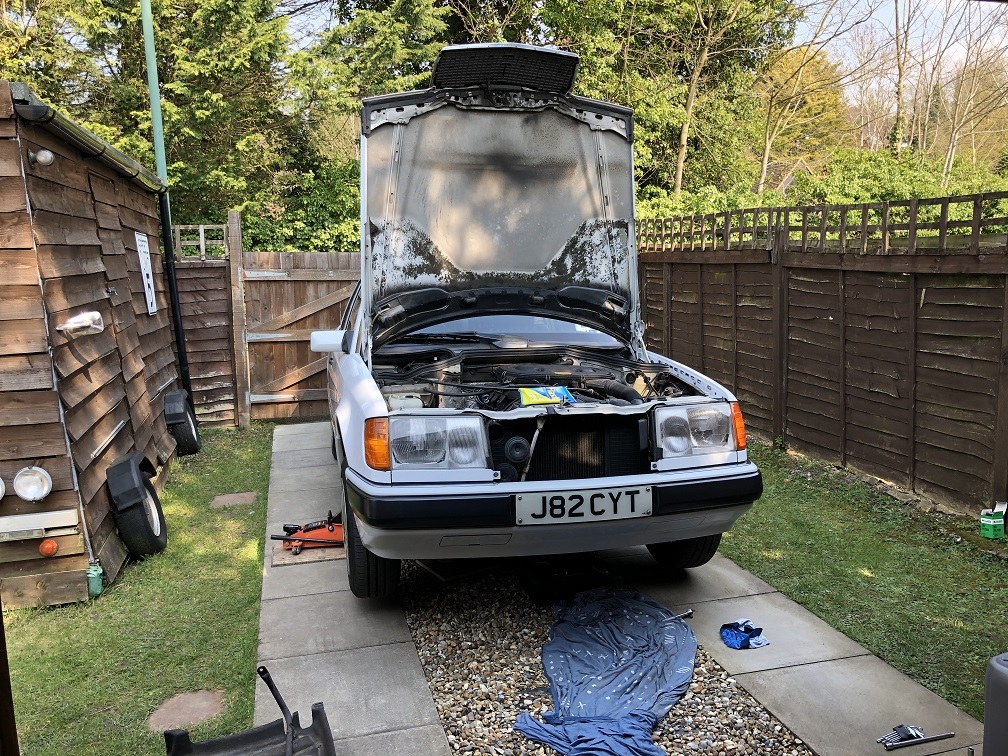 With the metal sump guard removed, the sump plug is easy enough to get to. 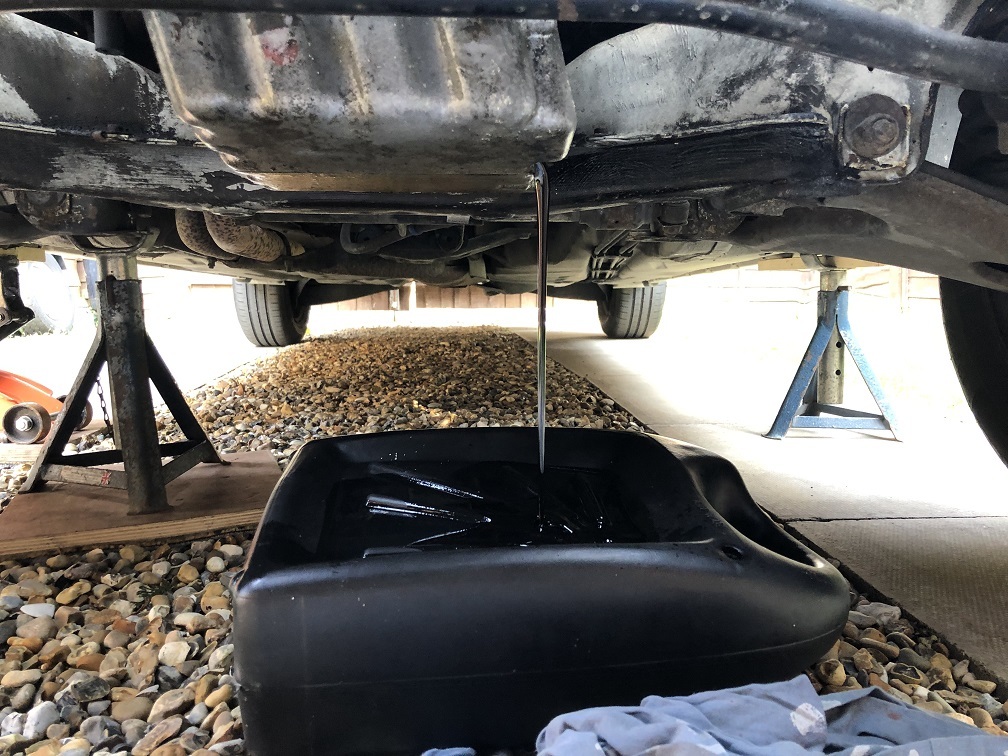 Which is something that you can't say for the oil filter, which is tucked away to the rear of the engine, close to the bulkhead. 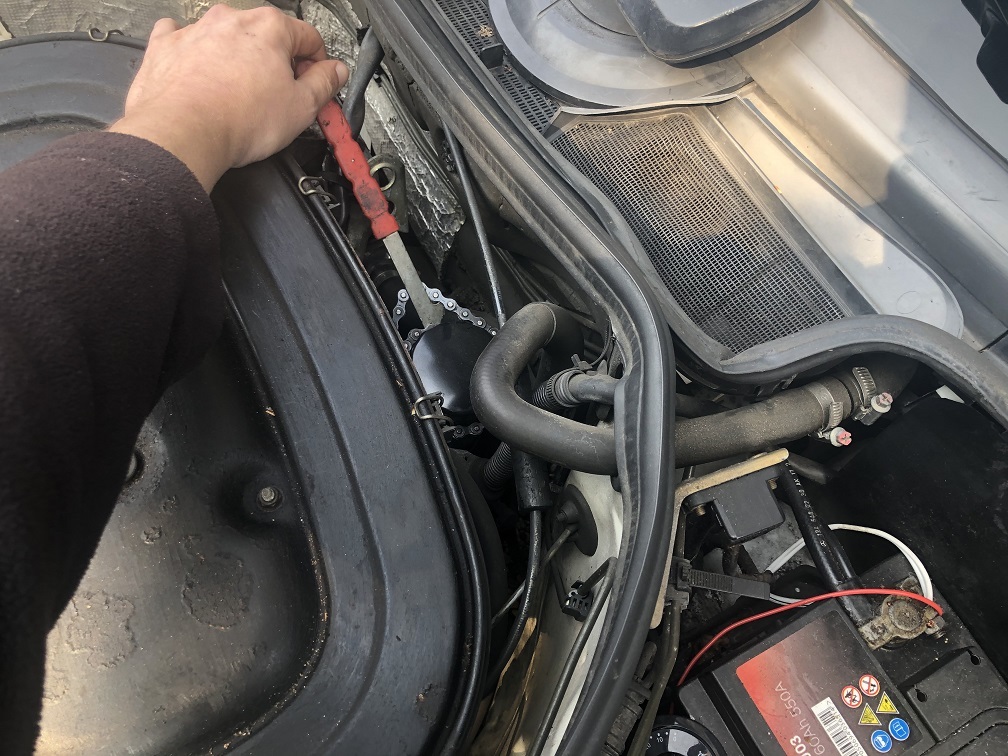 To get the oil filter off, the air filter housing had to come off. 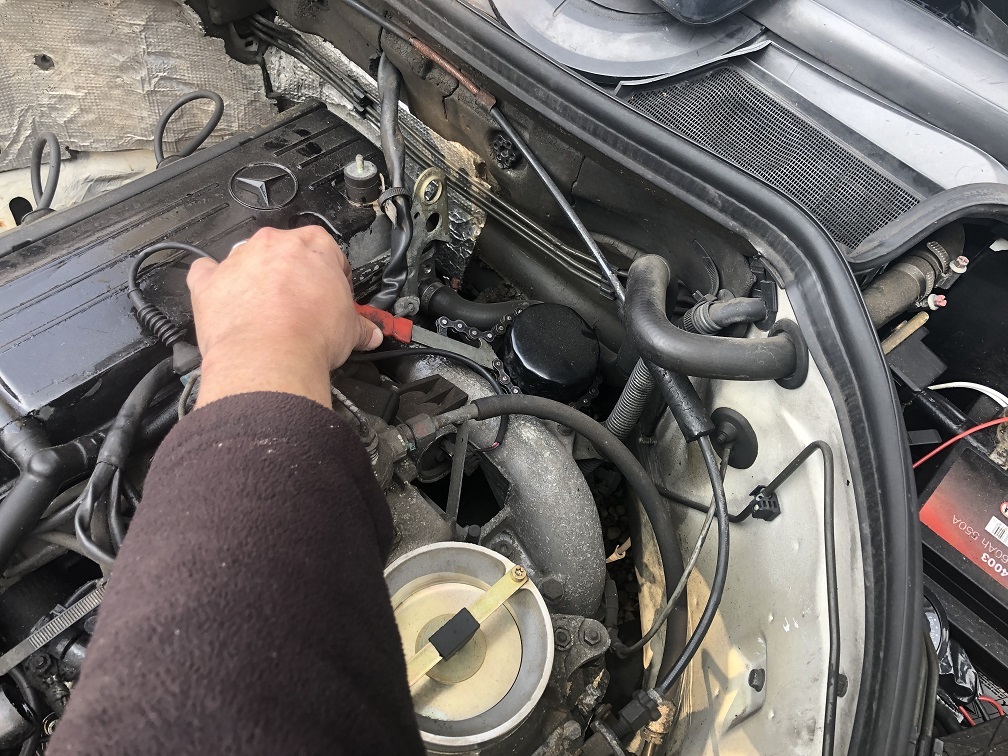 One issue that keeps reoccurring, most likely to the cool engine temperature issue, is a build up of mayo on the underside of the expansion tank cap. 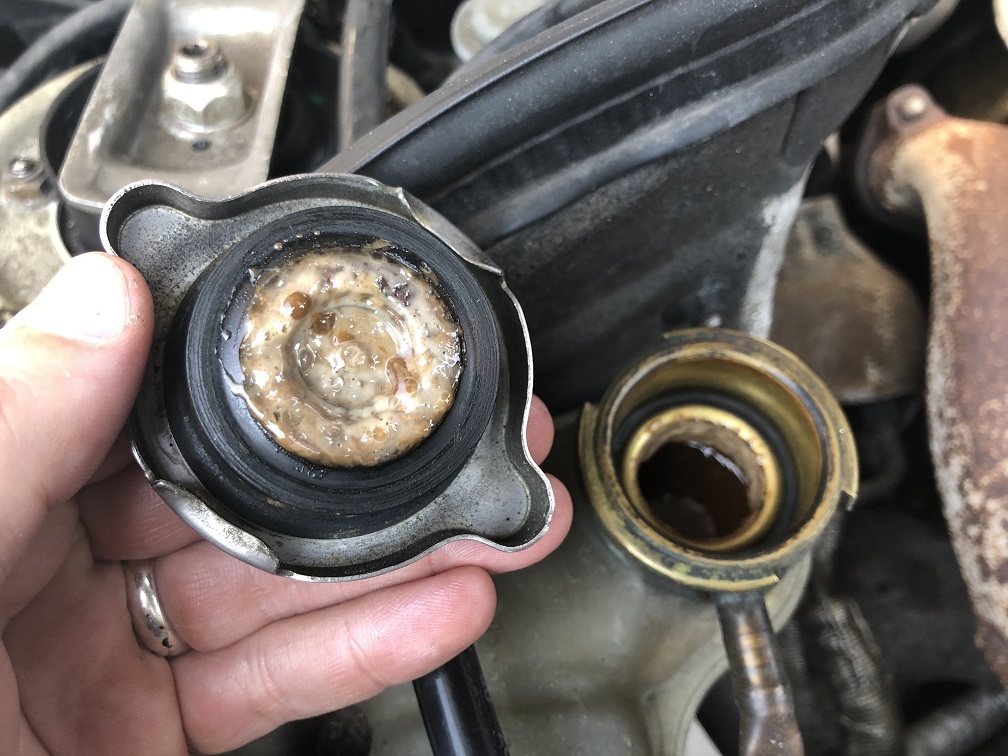 The mayo cannot be related to HGF as the old engine oil came out nice and black and everything looks good under the cam cover. 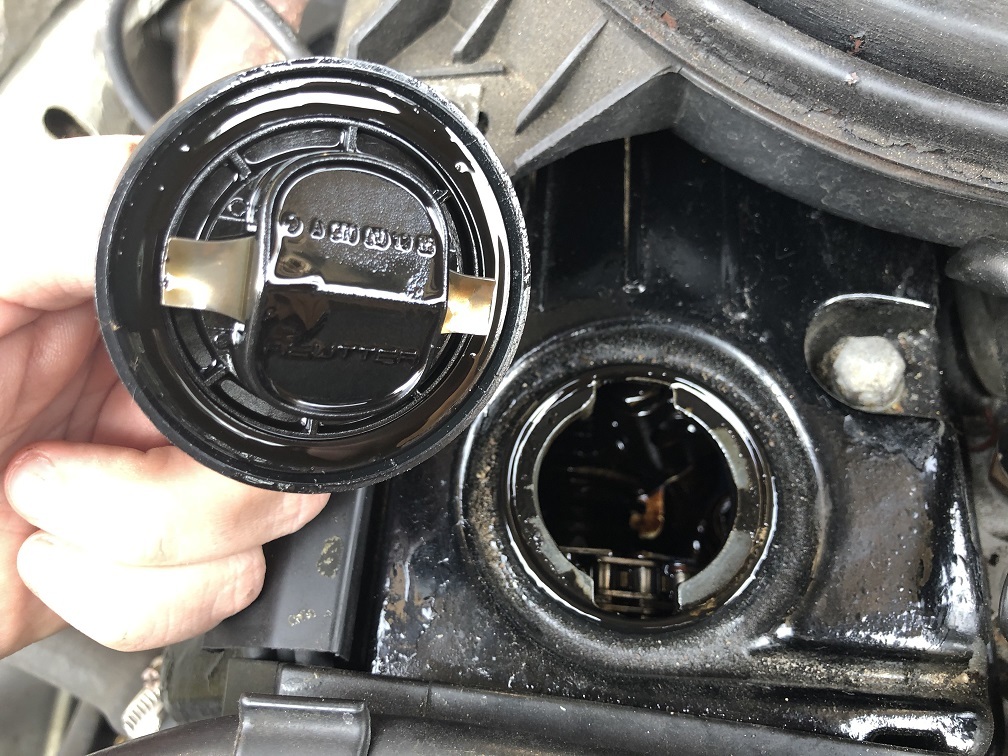 All being well, my next essential journey will be on Tuesday morning. |
| |
|
|
|
|
|
Mar 28, 2020 16:34:33 GMT
|
|
Notmally see the mayonnaise on cars that do a lot of short journey as the engine isn't getting up to temperature for long enough to burn off condensation. The winter time probably isn't helping.
|
| |
|
|
urbanaw
Part of things
 
Posts: 249
Club RR Member Number: 17
|
|
Mar 28, 2020 20:40:17 GMT
|
|
I really do not want to sound like the angel of doom here but the mayo in the expansion tank is oil in the coolant. Short journeys and condescension connected to it would show as mayo on the oil cap.
How can condensation from short journeys form mayo in the bottle full of coolant?
Please correct me if I am wrong.
|
| |
|
|
|
|
|
Mar 29, 2020 14:48:11 GMT
|
I really do not want to sound like the angel of doom here but the mayo in the expansion tank is oil in the coolant. Short journeys and condescension connected to it would show as mayo on the oil cap. How can condensation from short journeys form mayo in the bottle full of coolant? Please correct me if I am wrong. I misread that. Should have had my specs on. You're right sounds like oil in the coolant |
| |
|
|
urbanaw
Part of things
 
Posts: 249
Club RR Member Number: 17
|
|
Mar 29, 2020 21:25:01 GMT
|
I really do not want to sound like the angel of doom here but the mayo in the expansion tank is oil in the coolant. Short journeys and condescension connected to it would show as mayo on the oil cap. How can condensation from short journeys form mayo in the bottle full of coolant? Please correct me if I am wrong. I misread that. Should have had my specs on. You're right sounds like oil in the coolant Yes, it does. HG failure can mean oil being blown into the coolant. G. |
| |
|
|
|
|
|
Mar 30, 2020 12:18:25 GMT
|
I misread that. Should have had my specs on. You're right sounds like oil in the coolant Yes, it does. HG failure can mean oil being blown into the coolant. G. I rarely do just short runs but due to the engine not reaching full temperature on most of them, I hope that the mayo is due to condensation. I had another look at the coolant reservoir yesterday and noted a small layer of mayo sitting on top of the coolant, which was otherwise clean. This means that the coolant is not mixing with the mayo, which is why I think that the issue is related to condensation rather than oil and water mixing together. |
| |
|
|
Phil H
Posted a lot
  
Posts: 1,448
Club RR Member Number: 133
|
|
Mar 30, 2020 12:27:02 GMT
|
 Unless I've missed something here..you've got "mayo" on the coolant reservoir cap. "Mayo" is an emulsion - a mixture of oil and water. The coolant reservoir contains water, not any oil under normal circumstances. That means oil has got into the cooling system. That's either a) someone put the wrong stuff in the wrong hole b) a head gasket issue c) failure of another component where both oil and water are present (such as an oil cooler). Mayo doesn't magically appear in the coolant reservoir due to short journeys. |
| |
|
|
|
|
|
Mar 30, 2020 12:30:45 GMT
|
I am not the kind of guy to sit in a field full of old cars and chat with their giffer owners, however on a few occasions I found myself being asked to show the engine bay of my W123 230E. Whilst I took good care of the bodywork and interior, I paid less attention to the engine bay, which I must confess was dirty and looking dilapidated. Approx 3-4 years ago, I took the 230E off the road for a few weeks, stripped the front end and restored the engine bay to the condition that you can see in photos presented on the previous page. This was work in progress: 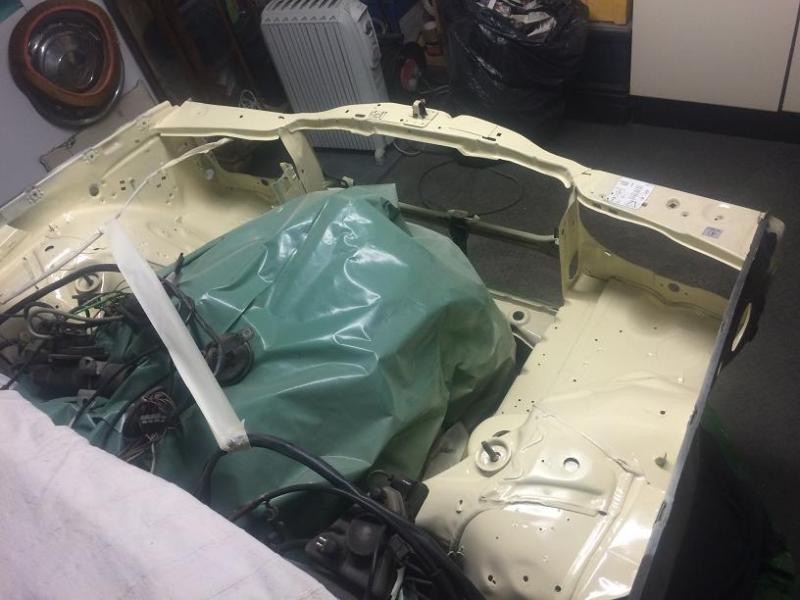  I have since kept the engine bay clean and I am happy to lift the bonnet whenever asked to display the engine. Whilst the 200E is unlikely to ever show its face at a classic car show, I had noted that the engine bay looked a bit ropey. As I have spare time to kill and left over materials in the garage from previous projects, I decided it was time for a tart up. 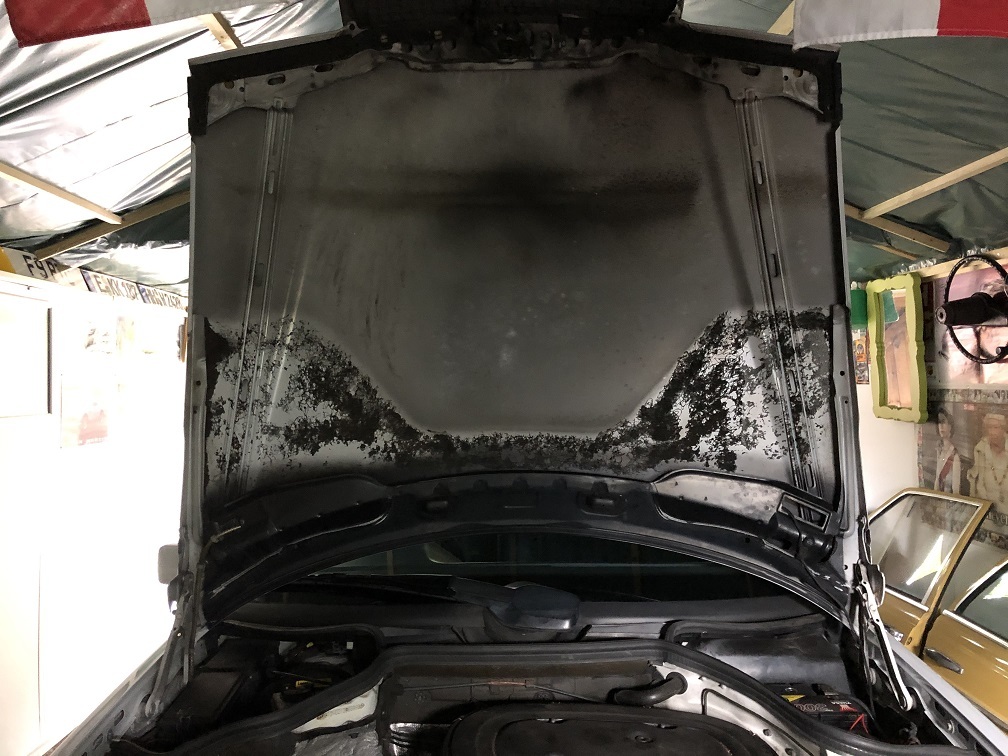 First part of the process involved cleaning the underside of the bonnet with Flash wipes. By the time I cleaned half of the bonnet there was no going back. 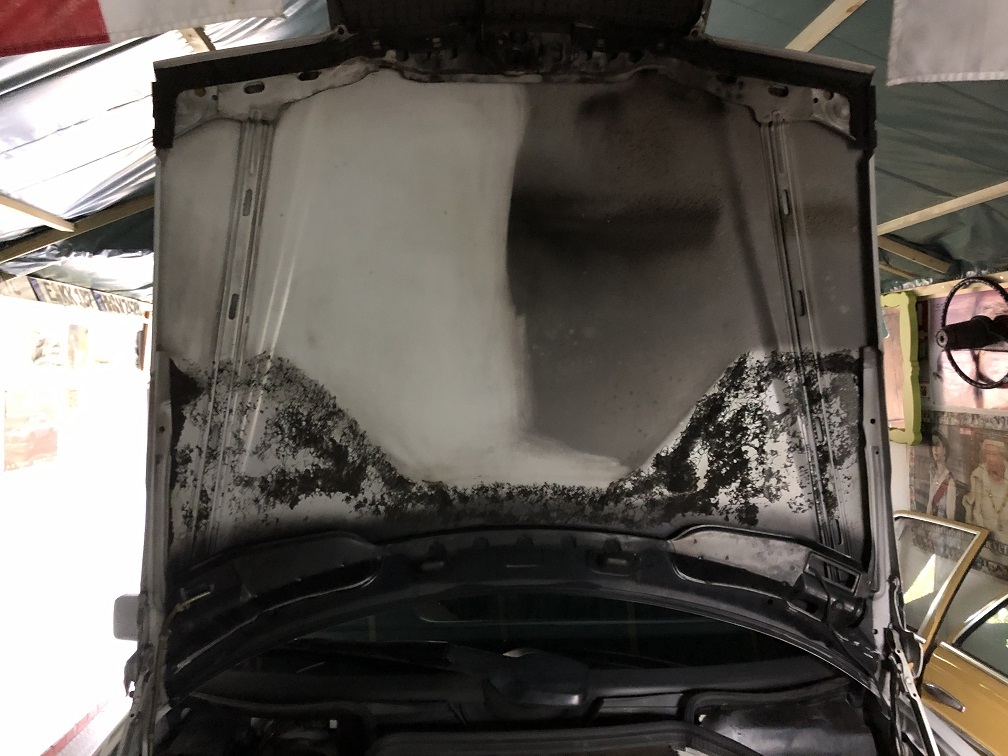 It was obvious that just a wipe over would not suffice.  Time to bring out the power tools.  There was no way of getting the old adhesive off and I don't want to pay £50+ for new sound insulation. The no-cost solution was to paint the underside of the bonnet black, to match the already black painted bottom part of the panel. That looks much better. 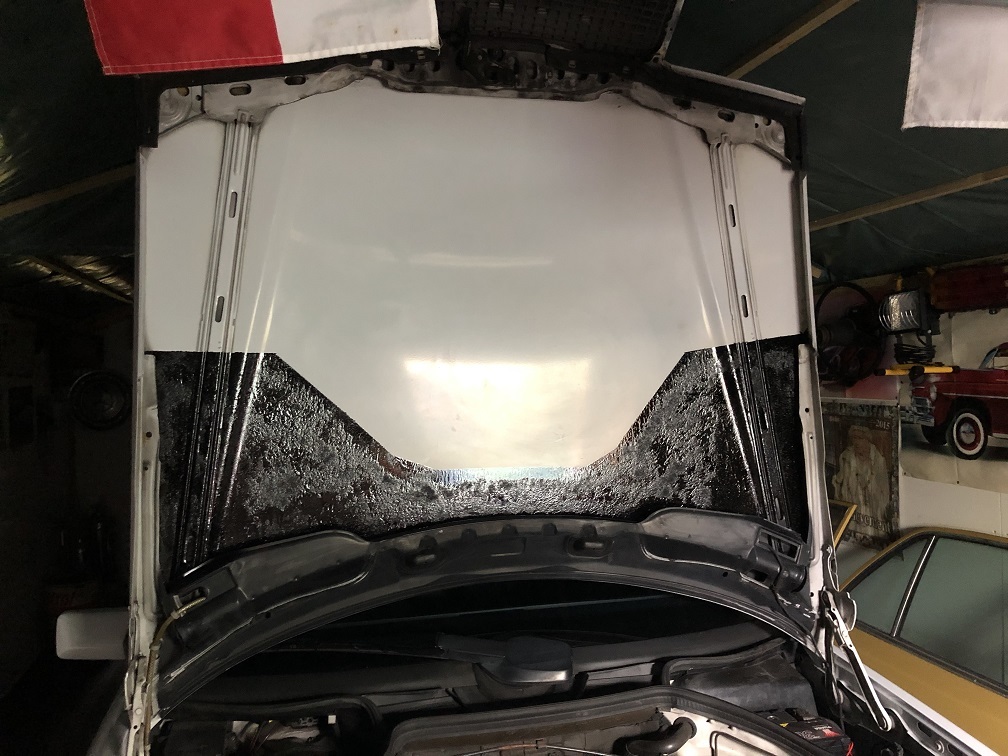 When I first bought the 200E, the air filter housing cover was quite rusty. I temporarily painted it with waxoil and whilst the corrosion was concealed, it was no thing of beauty. 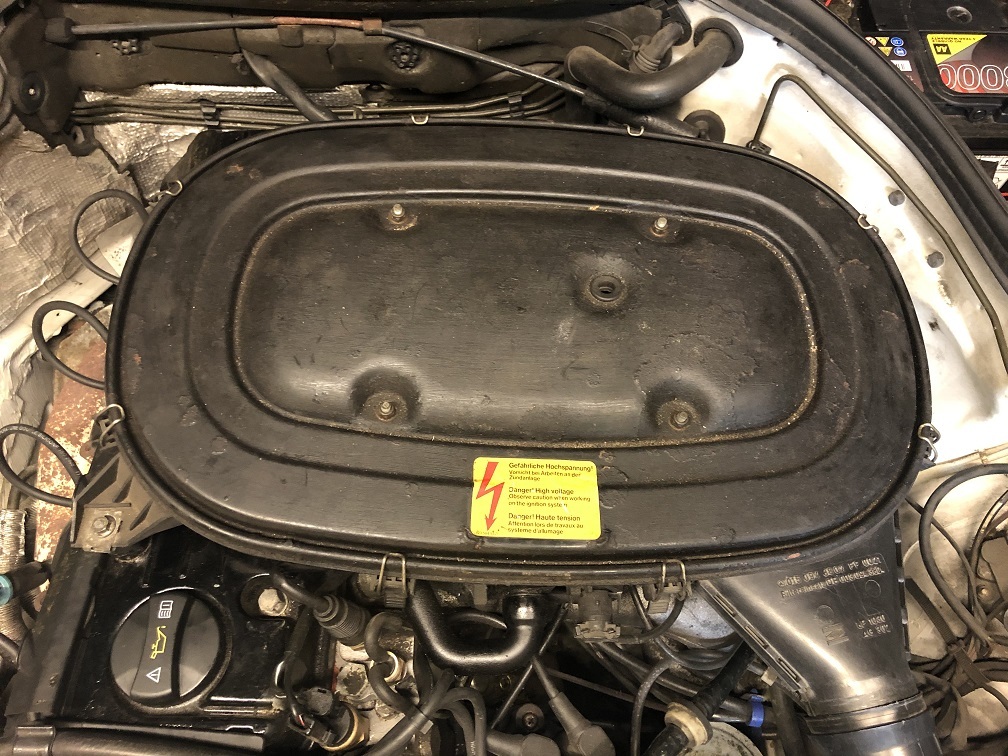 I removed most of the old paint and rust. I am not a fan of leaving the metal bare, after all the air filter housing sits on a Mercedes four pot, not a big block Chevy. I painted the cover with high temperature enamel paint. 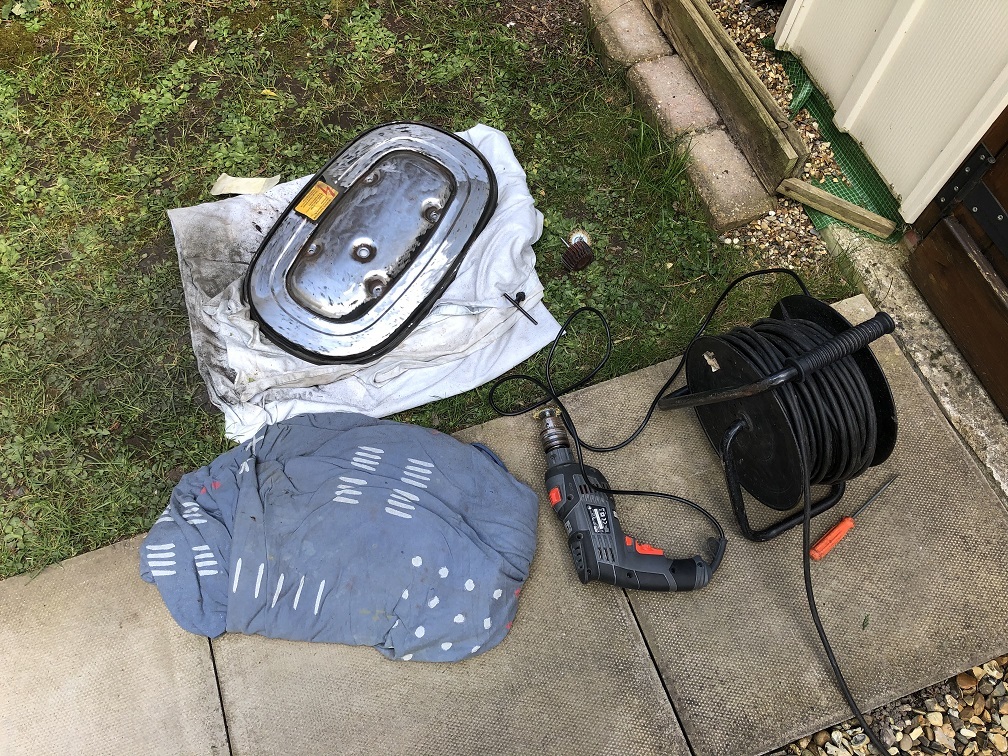 Another job done, with a shiny black air filter housing cover and a clean bonnet, the engine bay looks a bit more presentable. I am not going to spend more time perfecting the appearance of the engine bay as the 200E will inevitably go out in the rain in the future and end up covered with muck. 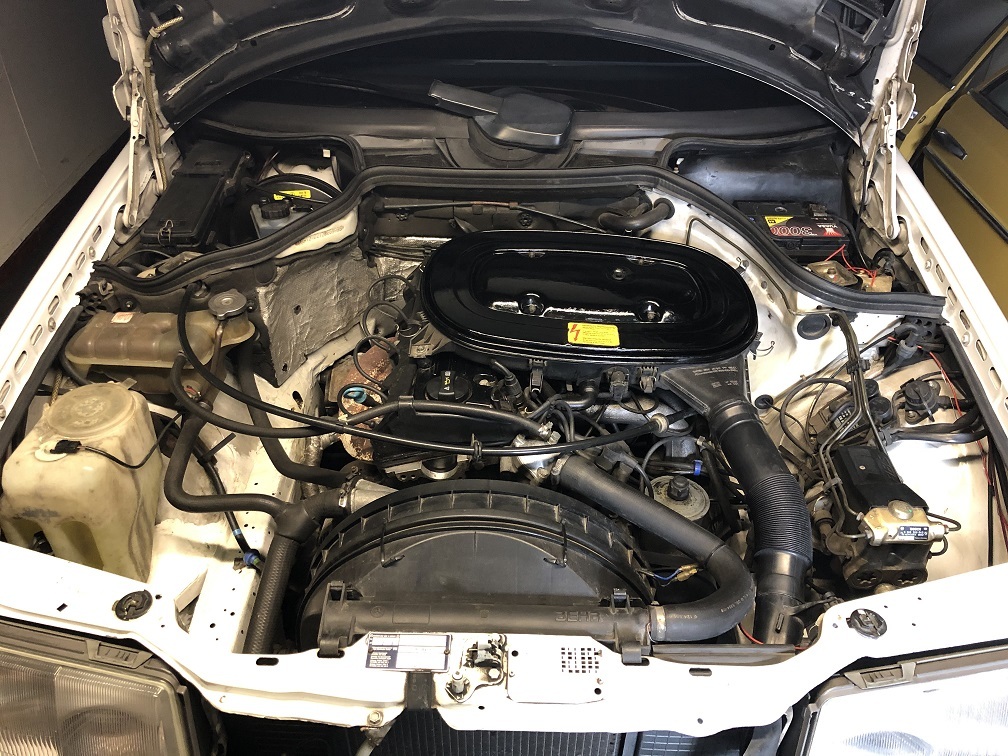 |
| |
|
|
|
|
|
|
|
Mar 30, 2020 16:01:13 GMT
|
 Unless I've missed something here..you've got "mayo" on the coolant reservoir cap. "Mayo" is an emulsion - a mixture of oil and water. The coolant reservoir contains water, not any oil under normal circumstances. That means oil has got into the cooling system. That's either a) someone put the wrong stuff in the wrong hole b) a head gasket issue c) failure of another component where both oil and water are present (such as an oil cooler). Mayo doesn't magically appear in the coolant reservoir due to short journeys. Thank you for your feedback. I have mayo on the underside of the coolant reservoir cap and a little more floating on top of the coolant in the reservoir. However, with the mayo cleared (there is not that much of it) the coolant underneath is clear. The last time I witnessed a HGF, the coolant reservoir was full of mayo. I have not put anything in the wrong hole outside of the bedroom for a long time. The head gasket may well be on its way out, however if that was the case, why is the engine oil black and the underside of the cam cover completely free from any mayo deposits? This car doesn't have any other coolers, which would enable water and oil to mix. Any ideas? |
| |
|
|
Phil H
Posted a lot
  
Posts: 1,448
Club RR Member Number: 133
|
|
Mar 30, 2020 16:06:10 GMT
|
|
The usual mixing pattern of HGF is water in the oil but it can go the other way - depending on the method of failure.
|
| |
|
|
|
|
|
Mar 30, 2020 16:18:10 GMT
|
The usual mixing pattern of HGF is water in the oil but it can go the other way - depending on the method of failure. If the reservoir is not full of mayo, perhaps the head gasket is only showing early signs of failure? I thought about adding K-Seal into the coolant. Might be worth a go? |
| |
|
|
|
|
|
Mar 30, 2020 17:58:30 GMT
|
The usual mixing pattern of HGF is water in the oil but it can go the other way - depending on the method of failure. If the reservoir is not full of mayo, perhaps the head gasket is only showing early signs of failure? I thought about adding K-Seal into the coolant. Might be worth a go? Don't put K-seal in it, that wont help in the situation you've got here. The leak wont be the gasket but the head casting itself corroding, M102 heads are known for it. If the damage is not too great I normally grind out and fill with weld, annealing it as I go with a hammer and punch. The other option is another cylinder head if you can find a good one. |
| |
1988 Mercedes w124 superturbo diesel 508hp
1996 Mercedes s124 e300 diesel wagon
1990 BMW E30 V8 M60 powered!
1999 BMW E46 323ci project car
|
|
Phil H
Posted a lot
  
Posts: 1,448
Club RR Member Number: 133
|
|
Mar 30, 2020 19:21:51 GMT
|
|
This is where my knowledge of the intricacies of various MB engine issues falls down - luckily this forum is full of many more knowledgeable souls than I.
My gut says it’s a leak/passage from the oil gallery feed to to the head into a waterway?
|
| |
|
|
urbanaw
Part of things
 
Posts: 249
Club RR Member Number: 17
|
|
Mar 30, 2020 23:09:32 GMT
|
|
My cylinder head was quite bad but not terminal. I had a leak between 3rd and 4th cylinder. An usual head skim gave it enough to make it perform well again.
|
| |
|
|
|
|
|
|
|
Gents, Thank you for all your feedback, I appreciate it. I've sniffed around on the internet and found this page: www.peachparts.com/shopforum/tech-help/78763-just-replace-head-gasket-do-lot-2.htmlThe guy had issues with mayo in the expansion tank of his M102 engined W201. Relevant extracts: After about 4 hours we finally had the head off. Everything looked clean and in good condition (as it should after only 90,000km and 11 years) except for the head gasket which was badly corroded around the coolant passages. This had been the case with the head gasket on our M103 when it suffered the same oil-in-coolant symptoms. This appears to be a common fault with these gaskets. The problem looks to be that no provision is made to prevent coolant from soaking into the gasket thus causing the steel layers to rust. I now change coolant annually (rather than every 3 years as our owner's manuals recommend) in an attempt to prevent this happening again.
Checking the head reveals that it is flat to within less than 0.002" or 0.05mm which is well within spec. A leak test on all the valves shows that they are sealing perfectly. For this reason I am not sending the head to an machine shop. I have cleaned it and will fit new valve stem seals when I get the gaskets etc. I have also decided to replace the head bolts after reading an article about "torque to yield" head bolts. It is also unclear as to the stretch limit of the bolts. Every shop manual I have for the M102 quotes the bolts at 119mm new with a max stretch length of 122mm. The bolts we removed all measure less than 115mm. Does anyone know the length they should be for a 1.8 litre M102?Now, I fully appreciate that this is one case out of thousands, however some of the feedback that the OP received confirms that Mercedes Benz head gaskets can fail with age. |
| |
|
|
|
|
|
|
|
Yesterday morning I made an essential 35 mile journey along the M40, M25 and back home the same way. On the motorway, the engine temperature reached: 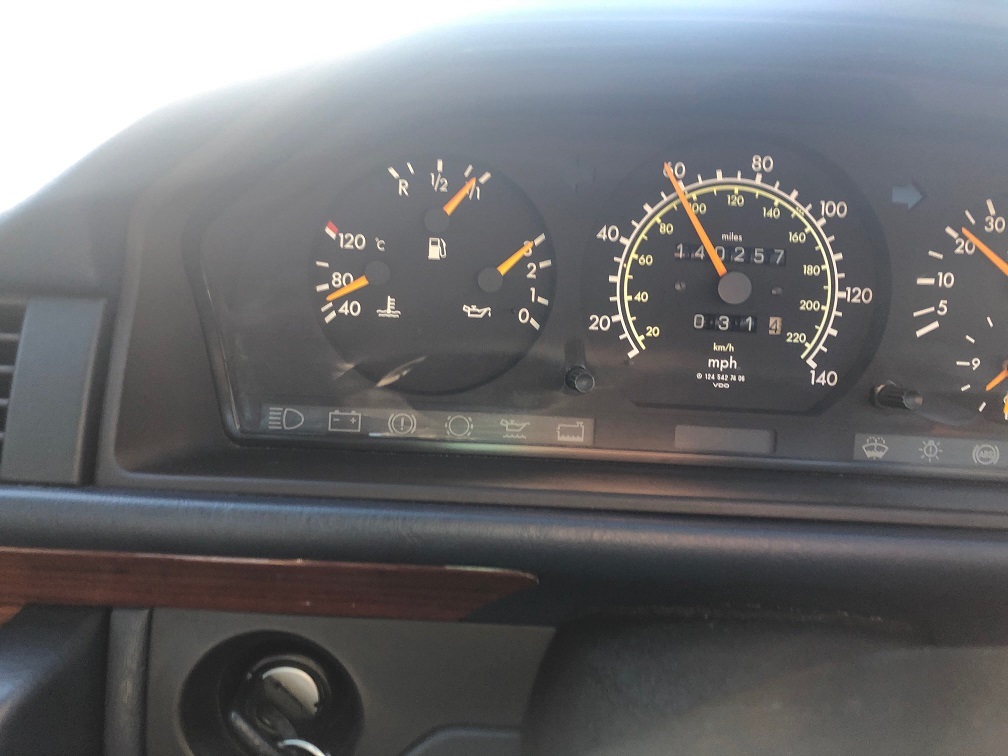 However, once I came off the motorway and drove through town at speeds of less than 30MPH and reached my destination, the engine was operating near enough at its correct temperature. 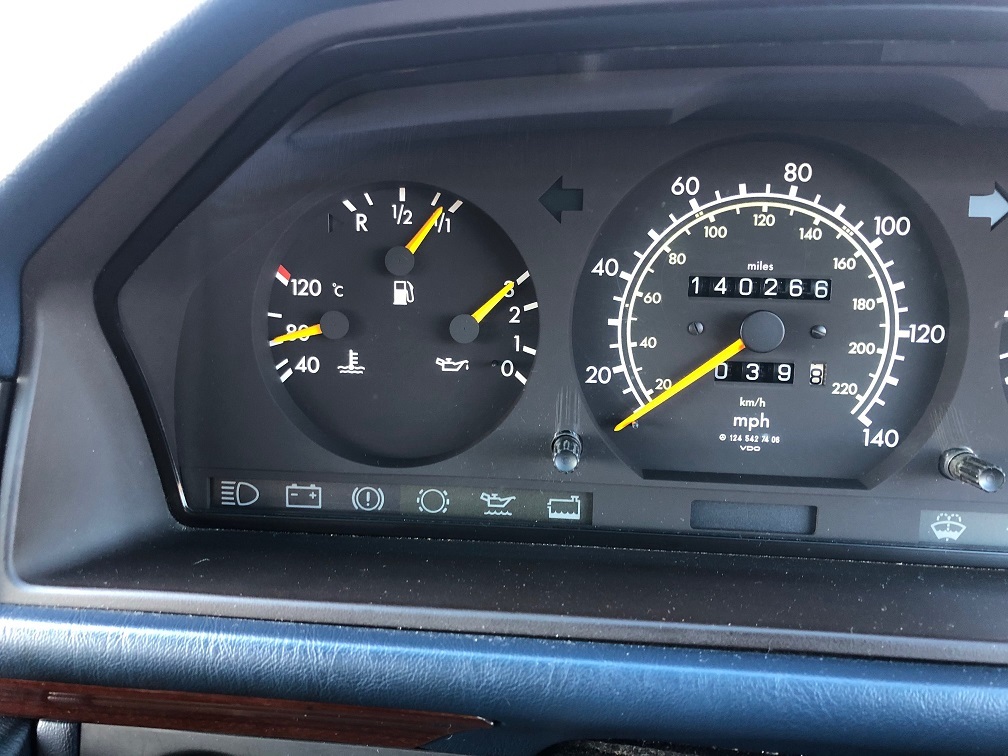 On route home I pushed the 200E up to 90MPH on a completely clear stretch of the M40. Once I got home and the engine cooled down a bit, I removed the expansion tank cap to find no evidence of any significant mayo build up. Deeper in the tank, the coolant was clean. If I have a cylinder head or head gasket problem, it's not massively serious just yet.  |
| |
|
|
urbanaw
Part of things
 
Posts: 249
Club RR Member Number: 17
|
|
|
|
|
I am sure it was a typo and you travelled at 70mph and not 90 as it reads. We would not exceed legal speed limits. Would we?
Previous owner of my Merc claimed to have been driving it for over a year with the symptoms of HG failure. I did a few short M25 journeys (one junction) and although it was getting worse by the day in the end it was still driveable.
It was a major, major pain to clean the expansion tank afterwards. It was black on the inside. I had to leave it to soak in tar remover for days and I still could not get rid off the muck.
|
| |
Last Edit: Apr 1, 2020 13:01:50 GMT by urbanaw
|
|
|
|
|
|
|
I am sure it was a typo and you travelled at 70mph and not 90 as it reads. We would not exceed legal speed limits. Would we? Previous owner of my Merc claimed to have been driving it for over a year with the symptoms of HG failure. I did a few short M25 journeys (one junction) and although it was getting worse by the day in the end it was still driveable. It was a major, major pain to clean the expansion tank afterwards. It was black on the inside. I had to leave it to soak in tar remover for days and I still could not get rid off the muck. My bad, it was 70MPH. I will keep an eye on the coolant situation for the time being but considering that we are in lockdown, the 200E won’t be going on a long journey for a while. The only aspect of the cylinder head removal that concerns me relates to the timing chain. I understand that it can be a pain to split and reassemble. Otherwise I’ve got the skill and tools to get the head off, get it skimmed and reassembled with a new gasket. |
| |
|
|
|
|


























